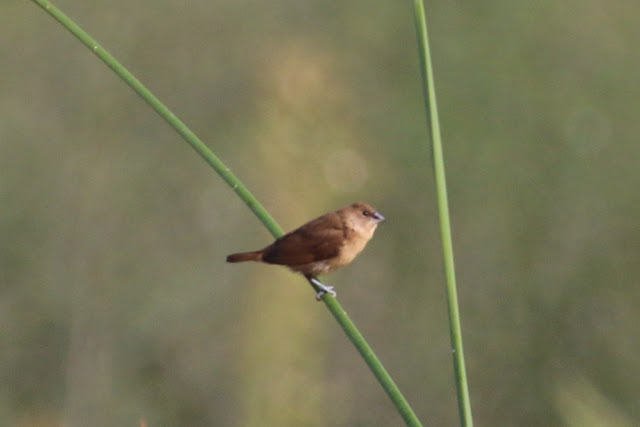While in California to play the Los Angeles Angels of Anaheim, it was an opportunity to see some species I've so-far missed this year on the California Coast; some ABA, some just for the Life List, but also a handful of exotics I didn't even know I was looking for, one of which was actually on the ABA List.
My first objective was the California Gnatcatcher. I've been to California enough times, you'd think I would have this on my ABA list. But I've just not spent enough time in the Los Angels area to figure out where these guys hang out. This time, with a full morning free to look, I headed out to the Upper Newport Bay at the foot of San Joaquin Hills Road, with hopes that e-Bird wouldn't steer me wrong.
It's a beautiful spot to go birding, and the California Gnatcatchers didn't disappoint. I heard one before seeing one and within 15 minutes of arriving I had another ABA Lifer for 2016. In 2015 I added 10 ABA Lifers, down from 15 the previous year, so I know it's getting harder to add Lifers each year without some very targeted travel, including Alaska.
651 for the ABA List, and 383 for the 2016 ABA List

After spending much of the morning exploring the Newport Backbay, I had a little time to scope out a destination for the next day and headed up to the San Juan Wildlife Sanctuary. I didn't have much time to explore, but I did hear that there were a couple of exotic birds being seen there: Scaly-breasted Munia and Northern Red Bishop, and it as it turned out, the munia is on the ABA List, so I had a destination for the following morning.
I was up early the next morning. I had to take an Uber to a university parking lot where I picked up my zip car, except this morning my zip car was missing from its parking spot. I had reserved a Ford Focus, as that's the car I drive at home, but it was not there. There was a VW Golf, but that was not what I reserved. I had to put in a call to Zip Car Central where they were sure I was missing something and they even honked the horn of the Focus and had a hard time believing I couldn't hear it. Eventually they set me up with the Golf and gave me a half hour discount and I was on my way to San Juan Wildlife Sanctuary. Before I even arrived I was treated to a flyover by not one, but six Elegant Terns. Wow. I was at a red light but didn't have time to get the camera out. I hoped perhaps they would land at the sanctuary, but no such luck.
When I did arrive, I didn't know exactly where the munia was, so I began my walk along the various trails and was treated to birds at every turn, including Forster's Terns, along with a great selection of sandpipers, American Avocets, Clark's and Western Grebes, a White-faced Ibis and the call of a Wrentit, the later two new for the year. I also saw a couple of coyotes but, alas, no American Roadrunner.
It wasn't until I was on the last leg of my walk that I encountered the exotics. As I was walking by an overgrown grassy field I saw something reddish-orange pop up and vanish just as quickly. It was the Northern Red Bishop. Good for the Life List, but not ABA countable. Next, I encountered a photographer who pointed out the ABA countable Scaly-breasted Munias. Lots of them, at least 30 by my rough count. I spent an hour watching and eventually photographing both the bishop and the munias before heading over to Mile Square Regional Park, at the suggestion of another birder.
Female Scaly-breasted Munia

Male Scaly-breasted Munia,(652 for the ABA List):
Northern Red Bishop
After circling the park and the nearby ball field area, I finally found an entrance and it truly is a mile square and lots of places to walk but not the birding bonanza I was lead to believe it was. Though I didn't find the Bullock's Oriole I went for, I did find Vaux's and White-throated Swifts, and Egyptian Geese, to keep the exotic theme going. I knew there are some purists, who don't like counting exotic birds, but if the ABA likes them, then that's good enough for me.
My final full morning of birding was spent at La Mirada Creek Park. Get there early and you're treated to another non ABA exotic, the Pin-tailed Whydah. There is a male in the park, though I was unable to find it; however I did find the half-dozen or so females from his harem, along with around 20 Scaly-breasted Munia, who seem to have a thriving population. I also added a Black-throated Gray Warbler and Pacific-slope Flycatcher.
Female Pin-tailed Whydah
I would say, given the usual limited time I have for birding on these trips, this was a successful few days of birding the LA area of California. I was able to add 8 species to the 2016 ABA list, and 2 ABA Lifers, the California Gnatcatcher and Scaly-breasted Munia, giving me 390 ABA + 3 exotics for the year and a ABA Life List total of 652 in less than five years of birding.
Now to see what seabirds I can add in Seattle the next couple of mornings.














